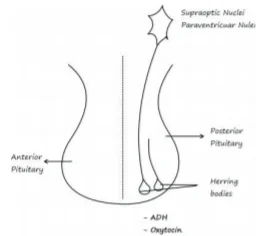Endocrine Glands: Anterior Pituitary and Posterior pituitary
Feb 17, 2023
Navigate Quickly
Major Glands
Anterior pituitary
Posterior Pituitary
Anterior Pituitary hormones
Following are the major anterior pituitary hormones
Metabolic functions
Non-Metabolic functions of growth hormones
Disorders of growth hormones
Regulation of GH secretion
Posterior Pituitary hormones
1. ADH
2. Oxytocin

Endocrine glands and their hormones play a critical role in regulating many physiological processes in the human body, such as growth, metabolism, reproduction, and homeostasis. Therefore, understanding the anatomy, physiology, and pathology of endocrine glands is crucial for medical professionals, including those who will be taking the NEET PG exam.
Endocrine-related questions are frequently tested in the exam, making it important for candidates to have a good grasp of this topic.
In this blog, you will get a quick overview of this important physiology topic for NEET PG exam preparation.

Major Glands
- Pituitary gland
- Pituitary gland has two lobes
- Anterior pituitary
- Posterior pituitary
- Pituitary gland has two lobes
Anterior pituitary
It has got glandular elements so it is called adenohypophysis.Cells in the anterior pituitary are
- Chromophobe cells - These constitute 50% of the anterior pituitary cells. They do not attract any color / stain
- Chromophyl cells- They constitute the rest 50% of the anterior pituitary cells. They attract some stains. These cells are further divided into two types
|
Acidophil cells |
Basophil cells |
|
|

Posterior Pituitary
It has neural elements because of which it is called neurohypophysis. Hormones of posterior pituitary are:
- ADH
- Oxytocin
These hormones are synthesized in the hypothalamic neurons. The nuclei where they are synthesized are supra optic nucleus (for ADH) & paraventricular nucleus (for Oxytocin).

Now let us discuss all the hormones of Anterior Pituitary and Posterior Pituitary individually.
Anterior Pituitary hormones
All anterior pituitary hormones are controlled by hypothalamic factors or hormones, EXCEPT, “prolactin”. For e.g. GH is controlled by GH inhibiting hormone called Somatostatin
Important Information
- TRH acts as prolactin releasing hormone
Following are the major anterior pituitary hormones
- GH (Growth Hormone)
GH is an anti-Insulin, diabetogenic hormone GH performs two types of function:
- Metabolic functions
- Non-metabolic functions
Metabolic functions
Metabolic functions of GH can be studied w.r.t. carbohydrates, proteins & fats that are discussed below:
- Growth Hormones & Carbohydrates
- GH is a hyperglycemic hormone. It causes hyperglycemia by preventing the peripheral utilization of glucose. In that way GH is acting upon exogenous glucose. As GH is diabetogenic, it results in Pituitary diabetes because of excessive GH secretion.
- Growth Hormone & Protein synthesis
- GH does not allow the protein breakdown as it promotes growth, rather it causes protein synthesis.
- Growth hormone action on fats
- GH causes breakdown of triglycerides. Therefore, it increases FFA (Free Fatty Acids) levels in the plasma.
Non-Metabolic functions of growth hormones
- GH causes somatic growth.
- Somatic growth means, the growth initiated by the action of mediators called Somatomedin or IGFs.
Disorders of growth hormones
Disorders of GH can be caused by either excess or deficiency of GH. Both of them are discussed below:-
- Excessive GH
- Excess of GH before puberty can lead to Gigantism.
- Excess of GH after puberty will lead to Acromegaly.
- Deficiency of GH
- Deficiency of GH before puberty leads to Dwarfism.
- Dwarfism is of three types :-
- Pituitary dwarf: These individuals have an absolute lack of GH before puberty.
- Levi- Lorain dwarfism: In this, the GH is normal but there is a deficiency of Somatomedin C (IGF I).
- Normal or increased GH dwarfism (Laron’s dwarfism): It is due to normal or increased GH but resistance to GH action (GH receptor insensitivity).
Regulation of GH secretion
- The stimulators of GH are :-
- GH- RH
- Hypoglycemia
- Exercise
- Arginine
- Sleep
- The inhibitors of GH are:
- GH – IH
- FFAs
- Hyperglycemia
Posterior Pituitary hormones
1. ADH
- ADH results into two actions
| Vasoconstriction | Water reabsorption from Renal tubules |
| It is mediated by a V1 receptor. | It is mediated by V2 receptors It happens when ADH binds with the V2 receptor in the collecting duct, there are insertions of channels called Aqua-porins II (AQP II) that results in reabsorption of water in the collecting duct. |
Important Information
- Neurophysin
- These are the proteins which bind ADH & Oxytocin and carry them down to the posterior pituitary gland.
- Herring bodies
- These are the bulb like bodies released from the axonal endings in the posterior pituitary.
2. Oxytocin
- It is involved in the positive feedback mechanism and neuroendocrine reflex. Oxytocin performs the following important functions:
- Milk ejection by contraction of the Myo-Epithelial cells of the breast.
- Parturition i.e. the delivery of a baby.
- Luteolysis i.e. degeneration of the corpus luteum.
Important Information
Neuro-endocrine reflex
- It is the reflex for which afferent limb is neuron and efferent limb is hormonal.
- For e.g. milk ejection.
To learn about the endocrine glands in detail watch the video lectures available on the PrepLadder app.

PrepLadder Medical
Get access to all the essential resources required to ace your medical exam Preparation. Stay updated with the latest news and developments in the medical exam, improve your Medical Exam preparation, and turn your dreams into a reality!
Top searching words
The most popular search terms used by aspirants
- NEET PG Physiology
- NEET PG Preparation Tips
PrepLadder Version X for NEET PG
Avail 24-Hr Free Trial